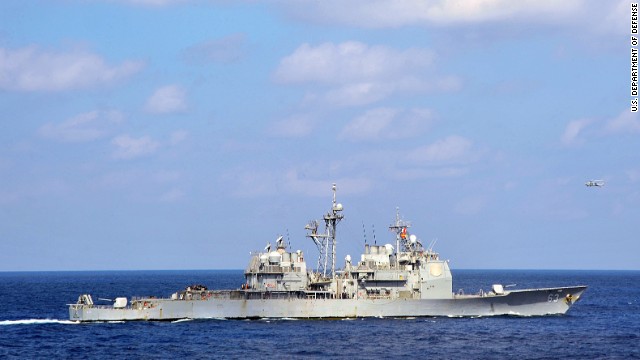U.S., Chinese warships come dangerously close
December 13, 2013 -- Updated 2352 GMT (0752 HKT)

The
guided missile cruiser USS Cowpens on December 6 was involved in an
incident with a Chinese military vessel, U.S. military officials
confirm.
.
The incident last Friday,
which was resolved peacefully, was the latest sign of tension around
recent and aggressive Chinese territorial claims in the region involving
international waters and expanded airspace.
Vice President Joe Biden
last week pressed Beijing over the issue, which stems from a
longstanding dispute with Japan that has grown tenser.
Several U.S. military
officials confirmed details of the incident on the high seas involving
the USS Cowpens, which has just come to light.
The American warship --
which U.S. officials say was in international waters -- was approached
by a Chinese Navy ship. The smaller vessel peeled off from a group of
Chinese Navy ships that included the carrier Liaoning.
The Chinese ship failed to stop, despite radio warning from the Cowpens that it was getting too close.
The Cowpens commanding
officer then issued orders for an "all stop" when the other ship was
less than 500 yards off its bow, a U.S. Navy official said.
The Chinese ship proceeded past the Cowpens.
"It is unusual to have to take evasive action at sea to avoid a collision," the official added.
While naval vessels from
different countries often come close as they observe each other, the
United States sees this case as one that could have led to a collision
because of the time and distance it takes for an American warship to
stop.
"The Chinese knew what they were doing," a second U.S. military official said.
During the encounter, bridge-to-bridge radio communications were maintained between the American and Chinese commanders.
"Communications were professional," the second official said.
Though the United States
will not acknowledge it openly, the Cowpens was in position to conduct
surveillance on the Liaoning, which would be a sensitive matter for the
Chinese.
U.S. officials insist the Cowpens remained in international waters at all times.
During a visit to
Beijing last week, Biden told Chinese President Xi Jinping the United
States had "deep concerns" over its newly declared East China Sea air
defense zone and that Washington did not recognize it.
The Chinese action, Biden said in Japan before the Xi visit, raised the possibility of "accidents and miscalculation."
The area in question
includes uninhabited islands that have been the site of tense disputes
between China and Japan, both of which claim the lands.
